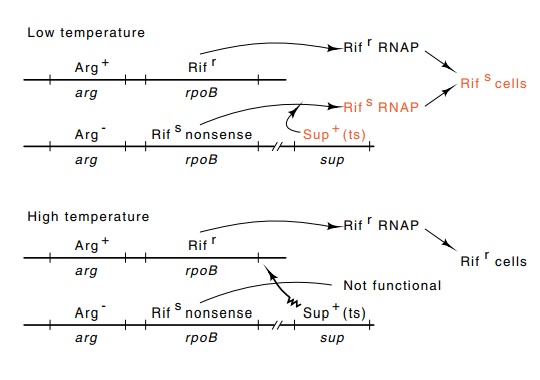Chapter: Genetics and Molecular Biology: Genetics
Genetic Selections
Genetic Selections
In the
preceding section we saw the use of penicillin for the selection of Leu-
mutants. Here we will further discuss genetic selections. Selective growth of
mutants means using conditions in which the desired mutant will grow, but the
remainder of the cells, including the wild-type parents will not. This is to be
contrasted with scoring, in which all the cells grow and the desired mutant is
identified by other means. Often in scoring, all the cells are plated out to
form colonies. These are then spotted onto various media on which the mutant
may be identified or are grown for assay of various gene products. A simple
example of selecting a desired mutant would be isolating a Lac+revertant
from a Lac- mutant by plating the cells on minimal plates containing
lactose as the sole source of carbon. Up to 1011 cells could be
spread on a single plate in search of a single Lac+ revertant.
A
slightly more complicated mutant selection is the use of an agent whose
metabolism will create a toxic compound. Cleavage of orthoni-trophenyl-β-D-thiogalactoside by the enzyme β-galactosidase yields a toxic
compound and cells die. Thus Lac+ cells expressing β-galactosi-dase in a medium
containing glycerol and orthonitrophenyl-β-D-thiogalactoside are killed and
only Lac- cells survive (Fig. 8.17).

Let us
examine a more complicated selection, the isolation of a nonsense mutation in
the β subunit
of RNA polymerase. Such a muta-tion would be lethal under normal circumstances
since RNA polymerase is an essential enzyme and a nonsense mutation terminates
translation of the elongating polypeptide chain. Tricks can be devised however,
so that the desired mutant can be identified if the cells contain a
tempera-ture-sensitive nonsense suppressor, Sup+(ts). Such a
suppressor results from a mutant tRNA that suppresses nonsense codons, but
loses its

Figure
8.18 Selection for a strain containing
a nonsense mutation in theβsubunit
of RNA polymerase.
suppressing
activity at 42°, a
temperature at which Escherichia coli
normally survives. The selection also utilizes the RNA polymerase inhibitor,
rifamycin.
Two facts
are key to the selection: first, that rifamycin sensitivity is dominant to
rifamycin resistance, and second, that rifamycin-resistant mutants possess
altered β subunits
of RNA polymerase. One might have thought that resistance would be dominant to
sensitivity, for it would seem that the rifamycin-resistant polymerase in a
cell could function despite the presence of the sensitive polymerase. Problem
8.20 asks why sensitive polymerase is dominant to resistant polymerase. The
first step in selecting the desired mutant is to mutagenize Arg- Rif
s Sup+(ts) Smr (streptomycin-resistant) cells
and to grow them at the low temperature of 30°. Under these conditions, a nonsense mutation in
the rif allele would not be lethal
since the suppressor would be active and the complete β chain of polymerase would be
synthesized (Fig. 8.18).
After the
first step, a region of the chromosome containing the Arg+ Rifr
genes could be introduced by mating with an appropriate Sms strain
containing an Arg-Rif episome (see later section for episomes). By selecting
for growth in the absence of arginine and presence of strepto-mycin, cells
diploid for this region could be selected. The majority of the cells which grow
will then have the genotype Arg+ Rifr/ Arg-
Rifs Sup+(ts) Smr, in which the genes before
the “/ ” represent episomal genes.
Among
these will be a few of the desired genotype, Arg+ Rifr/Arg-Rifs(amber) Sup+.
Since rifamycin sensitivity is dominant to rifamycin resistance, the cells with
the amber mutation in the β subunit will be rifamycin-resistant at 42 whereas the others will remain
rifamycin-sensitive. The desired cells, but
not most of the other types, would be able to grow at 42° on
minimal medium lacking arginine and containing rifamycin. One of the nondesired
mutant types would be those with missense mutations in the β subunit. How could these be
distinguished from those with nonsense mutations in β? The answer is that the missense
mutations would remain rifamycin-resistant even at 30°, whereas
the amber mutants would become rifamycin-sensitive!
Related Topics